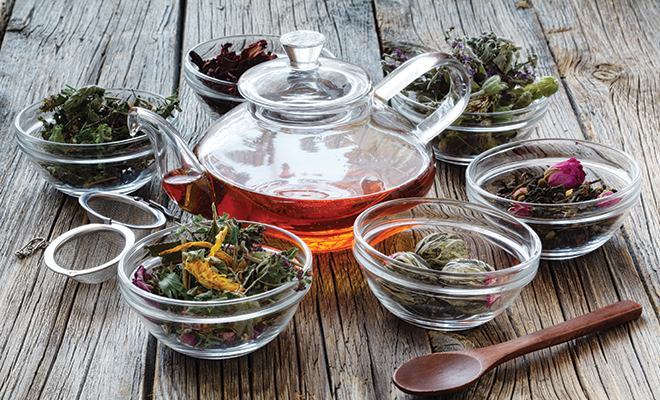
Grow a Healthful Garden!
Modern medicine has great advantages, but as more people become aware of the positive effects of natural products, using herbs for medicinal use is again gaining acceptance; new research is finding that many ancient herbs are useful and effective. Here are four of the most popular herbs to grow and use.
Chamomile
It’s one of the best known of the medicinal herbs. As a pleasant-tasting tea, it can be used to relax, for migraine headaches and for mild digestive problems, especially when combined with ginger root. In Europe, it’s used in an antibacterial compress to help heal wounds and lessen swelling.
Chamomile is pretty but not showy, with small daisy-like flowers. It can grow in most locations, but it does best in cool conditions and in partial shade. It should not be overfertilized or overwatered. Like many herbs, once established, it needs little care.
Steep dried leaves and flowers as you would a regular tea, adding a little honey if you prefer. While the herb is considered safe by the FDA, people with ragweed allergies, on blood thinners or taking prescription sedatives may need to avoid chamomile.
Echinacea
The purple coneflower Echinacea purpurea is a popular garden plant because of its bright butterfly-friendly flowers that bloom all summer. It’s also a well-known herbal remedy for fighting colds and upper respiratory infections, lessening the symptoms by stimulating the immune system. An infusion of the plant can be used to help soothe sunburn and treat rashes.
Echinacea does best in rich, well-drained soil, in part shade/part sun or full sun. These are large plants, growing to a height of a foot or more, spreading up to three feet. They are drought-tolerant perennials, but watering during dry periods is recommended. Deadheading encourages more flowers to grow.
There are many varieties of echinacea, all containing beneficial compounds. The three most popular are the narrow-leaved coneflower, the pale purple coneflower and the eastern purple coneflower.
Make a tea using fresh or dried leaves or flowers, gently simmering for 15 minutes, then straining and adding honey. Sip slowly, breathing in the steam.
Warning: persons taking immune-boosting drugs, muscle relaxants or blood pressure medicine may find the herb can increase side effects or decrease the effectiveness of these medications. Long-term use is not recommended.
Lavender
Popular in Victorian times, lavender has gained new popularity as an aromatherapy treatment, with a number of cosmetic and medicinal uses. These plants do best in Mediterranean climates, with cool, moist winters and hot, dry summers, but there are many varieties of lavender, including cold-tolerant types and some that do well in hot climates. Plants require at least six hours of full sun each day, in well-drained soil. Your local plant nursery or agricultural extension center can suggest the best for your area.
Lavender sleep pillows, small sachets filled with the herb, can be used to encourage sleep. Some studies have found that breathing lavender steam can be effective as an aromatherapy treatment for PMS and for tension headaches. The oil can be used to treat mild burns, bug bites and other skin irritations when diluted with another natural oil, but should not be taken internally, as it can be toxic.
Cats can have a severe adverse reaction to the herb or oil in any form, including when used in aromatherapy. However, lavender aromatherapy can be used successfully to reduce anxiety in dogs. Consult your veterinarian.
Sage
A well-known culinary herb, sage has a number of clinically demonstrated uses. Even a single dose, taken as an infusion, can help increase memory and attention in healthy adults. A cream made of sage and rhubarb extract, applied every few hours, can be as effective in treating cold sores as some prescription products. Sage extract or tea has been proven to help decrease hot flashes.
Sage is easy to grow indoors near a sunny window. Don’t overwater; wait until the soil is dry before watering. Outside, sage is hardy. Start seeds indoors or plant established plants outside when the soil is above 60º, then harvest the leaves as needed. Sage comes in a number of colors–any can be used medicinally–and it can produce pretty purple flowers. In cold climates, cover the plants at the approach of winter.
Some species of sage contain small amounts of the neurotoxin thujone. Drinking more than six cups of sage tea a day is not recommended.
As with any medical treatments, there can be side effects. Before using herbs to treat any ailment, talk to your doctor to see if there are any counterindications, especially if you take any prescription drugs or have any chronic conditions. ■
Sources: anniesremedy.com, motherearthliving.com, naturallivingideas.com, nlm.nih.gov and webmd.com.







